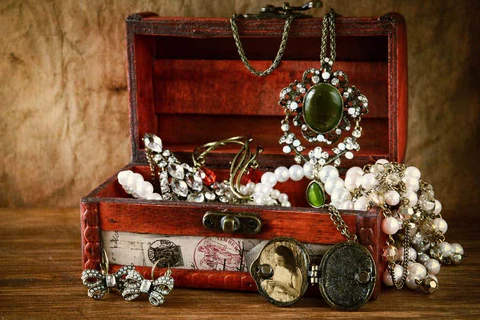There’s something enchanting about owning a piece of history. Antique jewelry, with its unique craftsmanship and character, offers a glimpse into the past. Unlike modern jewelry, antique pieces carry stories, mystery, and a level of artistry that’s hard to find today. Each item has a life of its own, shaped by time and previous owners. Whether you’re a seasoned collector or new to the world of antique jewelry, there’s so much to explore, learn, and appreciate.
Why Choose Antique Jewelry?
Antique jewelry isn’t just beautiful; it’s also valuable. Owning a piece that has stood the test of time gives you a rare, tangible link to history. Here are some reasons why collectors seek out antique jewelry
- Unmatched Craftsmanship. Many antique pieces are handcrafted with techniques that are no longer used. This craftsmanship gives antique jewelry a distinct, high-quality feel that’s hard to replicate.
- Unique Designs. Trends today may come and go, but antique designs are often timeless. These pieces reflect the aesthetic values of the era they were made in, offering a sense of uniqueness.
- Investment Value. Antique jewelry often appreciates in value over time. If you choose pieces wisely, they can serve as both an accessory and an investment.
- Sustainability. Choosing antique jewelry is a sustainable option. You’re not contributing to new production, making it an eco-friendly choice.
Types of Antique Jewelry
Understanding the different types of antique jewelry helps in appreciating the range and history of these pieces. Here’s a quick guide to some popular styles you might encounter
- Victorian Era (1837–1901). This period is known for its romantic and ornate designs. Look for cameos, lockets, and intricate brooches. Jewelry from this era often includes gemstones like amethyst, garnet, and turquoise.
- Edwardian Era (1901–1915). Edwardian jewelry is light, lacy, and elegant. Pieces from this period feature platinum settings, diamonds, and pearls. Filigree work is common, giving a delicate, feminine feel to the jewelry.
- Art Nouveau (1890–1910). This style is characterized by flowing lines, nature-inspired designs, and vibrant enamel work. Art Nouveau jewelry often includes motifs of flowers, animals, and mythical creatures.
- Art Deco (1920s–1930s). Art Deco pieces are bold and geometric, often with symmetrical patterns. Diamonds, onyx, and emeralds are frequently used, creating a luxurious, modern look that’s still highly popular.
- Retro (1940s–1950s). Jewelry from the Retro era reflects Hollywood glamour. Expect bold, oversized designs with gold and synthetic gemstones. Retro pieces often make a statement and are perfect for adding a vintage touch to modern outfits.
How to Start an Antique Jewelry Collection
Starting a collection of antique jewelry doesn’t have to be daunting. Here are a few steps to help you get started
- Educate Yourself. Read up on different jewelry eras and styles. Familiarize yourself with famous designers and hallmark stamps that indicate authenticity.
- Set a Budget. Antique jewelry can vary widely in price. Decide on a budget before you start shopping to ensure you make wise purchasing decisions.
- Examine Condition. Antique jewelry will show some signs of wear, but excessive damage can reduce its value. Look for well-preserved pieces that don’t have significant flaws.
- Choose Quality Over Quantity. High-quality pieces are better than a large collection of lower-quality items. Look for materials like gold, platinum, and diamonds.
- Buy From Reputable Sources. To avoid fakes, always purchase from trusted dealers or certified antique stores.
How to Spot Authentic Antique Jewelry
Knowing how to identify authentic antique jewelry is crucial for any collector. Here’s a checklist for spotting genuine pieces
- Check for Hallmarks. Authentic antique jewelry often has hallmark stamps indicating the metal quality and origin. Familiarize yourself with these stamps for different periods.
- Inspect the Craftsmanship. Antique pieces are often hand-finished, so you may notice small imperfections. Machine-made jewelry usually lacks these details.
- Look for Age Indicators. Genuine antiques will show some signs of age. Check for slight patina on metals and minor wear on gemstones.
- Ask for Provenance. If available, ask the seller for information on the piece’s history or previous ownership. Provenance adds value and authenticity.
Caring for Your Antique Jewelry
Proper care is essential for preserving the beauty and value of antique jewelry. Here are some care tips to keep your pieces in top shape
- Store Separately. Keep each piece in a soft cloth pouch or a separate compartment to avoid scratches.
- Avoid Moisture. Store your jewelry in a dry place. Moisture can cause tarnishing or corrosion on metals like silver.
- Handle with Care. Antique jewelry can be delicate. Avoid wearing pieces during activities where they might be damaged.
- Use Gentle Cleaning Methods. Avoid harsh chemicals or ultrasonic cleaners. Instead, use a soft brush and mild soap to clean your pieces carefully.
- Regular Inspections. Get your jewelry checked by a professional every few years to ensure clasps, settings, and prongs are secure.
The Investment Potential of Antique Jewelry
Investing in antique jewelry can be rewarding. Unlike many modern items, well-maintained antiques tend to hold or even increase in value. However, the value of antique jewelry depends on factors like rarity, craftsmanship, and condition. Here are a few tips for those considering antique jewelry as an investment
- Research the Market. Study current trends and demand for specific periods or designers. Some eras, like Art Deco, are highly sought after and command higher prices.
- Choose Pieces with High Resale Value. Look for pieces with known provenance, rare gemstones, or unique designs. Items that are less common tend to have better resale potential.
- Maintain Condition. Value is significantly affected by a piece’s condition. Handle and store your jewelry properly to preserve its integrity.
- Hold for the Long Term. Antique jewelry isn’t a quick investment. Most pieces gain value over decades, so be prepared to hold onto your collection for some time.
Popular Antique Jewelry Designers to Know
Certain designers have become iconic in the world of antique jewelry. Here are a few whose work has stood the test of time
- Tiffany & Co. Known for its fine gemstones and innovative designs, Tiffany pieces from the Victorian and Edwardian eras are highly collectible.
- Cartier. Famous for Art Deco designs, Cartier’s jewelry often features platinum, diamonds, and geometric patterns. Pieces by Cartier are highly valuable and coveted.
- Georg Jensen. Specializing in silver, Georg Jensen’s work reflects the Art Nouveau and modernist styles. His pieces are minimalist but highly elegant.
- Boucheron. Founded in the 19th century, Boucheron’s designs often feature intricate details and high-quality stones. His work is rare and appreciated by collectors.
- Van Cleef & Arpels. Known for whimsical and nature-inspired pieces, Van Cleef & Arpels’ work is elegant and timeless. Pieces from this brand are some of the most valuable in antique jewelry.
Trends in Antique Jewelry Collecting
Antique jewelry collecting has seen a surge in popularity in recent years. Here are some trends shaping the market today
- Renewed Interest in Art Deco. Art Deco designs are experiencing a revival. Collectors are drawn to the bold, geometric shapes and luxurious materials.
- Sustainable Fashion. As people become more conscious of sustainability, vintage and antique pieces are in demand. Collecting antique jewelry is an eco-friendly way to enjoy luxury without supporting new mining or production.
- Focus on Personalization. More collectors are interested in unique, meaningful pieces. Antique jewelry offers one-of-a-kind items that reflect individual style.
- Mixing Eras. It’s common now to see people mix pieces from different periods. For example, pairing a Victorian locket with Art Deco rings creates a layered, eclectic look.
Final Thoughts on Collecting Antique Jewelry
Collecting antique jewelry is about more than acquiring beautiful pieces. It’s about connecting with history and appreciating fine craftsmanship that’s increasingly rare. These pieces aren’t just investments; they’re treasures. Whether you’re drawn to the elegance of Edwardian filigree or the bold shapes of Art Deco, antique jewelry offers something truly unique. So, take your time, choose carefully, and enjoy building a collection that reflects your style and passion.







